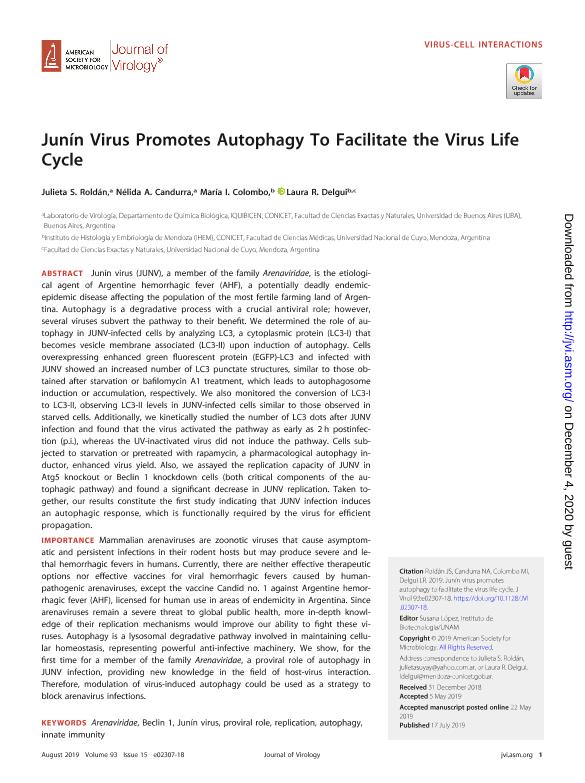Mostrar el registro sencillo del ítem
dc.contributor.author
Roldan, Julieta Suyay

dc.contributor.author
Candurra, Nélida Alicia

dc.contributor.author
Colombo, Maria Isabel

dc.contributor.author
Delgui, Laura Ruth

dc.date.available
2020-12-28T15:46:03Z
dc.date.issued
2019-07-17
dc.identifier.citation
Roldan, Julieta Suyay; Candurra, Nélida Alicia; Colombo, Maria Isabel; Delgui, Laura Ruth; Junín virus promotes autophagy to facilitate the virus life cycle; American Society for Microbiology; Journal of Virology; 93; 15; 17-7-2019; 1-16; e02307-18
dc.identifier.issn
0022-538X
dc.identifier.uri
http://hdl.handle.net/11336/121217
dc.description.abstract
Junín virus (JUNV), a member of the family Arenaviridae, is the etiological agent of Argentine hemorrhagic fever (AHF), a potentially deadly endemic-epidemic disease affecting the population of the most fertile farming land of Argentina. Autophagy is a degradative process with a crucial antiviral role; however, several viruses subvert the pathway to their benefit. We determined the role of autophagy in JUNV-infected cells by analyzing LC3, a cytoplasmic protein (LC3-I) that becomes vesicle membrane associated (LC3-II) upon induction of autophagy. Cells overexpressing enhanced green fluorescent protein (EGFP)-LC3 and infected with JUNV showed an increased number of LC3 punctate structures, similar to those obtained after starvation or bafilomycin A1 treatment, which leads to autophagosome induction or accumulation, respectively. We also monitored the conversion of LC3-I to LC3-II, observing LC3-II levels in JUNV-infected cells similar to those observed in starved cells. Additionally, we kinetically studied the number of LC3 dots after JUNV infection and found that the virus activated the pathway as early as 2 h postinfection (p.i.), whereas the UV-inactivated virus did not induce the pathway. Cells subjected to starvation or pretreated with rapamycin, a pharmacological autophagy inductor, enhanced virus yield. Also, we assayed the replication capacity of JUNV in Atg5 knockout or Beclin 1 knockdown cells (both critical components of the autophagic pathway) and found a significant decrease in JUNV replication. Taken together, our results constitute the first study indicating that JUNV infection induces an autophagic response, which is functionally required by the virus for efficient propagation. IMPORTANCE Mammalian arenaviruses are zoonotic viruses that cause asymptomatic and persistent infections in their rodent hosts but may produce severe and lethal hemorrhagic fevers in humans. Currently, there are neither effective therapeutic options nor effective vaccines for viral hemorrhagic fevers caused by human-pathogenic arenaviruses, except the vaccine Candid no. 1 against Argentine hemorrhagic fever (AHF), licensed for human use in areas of endemicity in Argentina. Since arenaviruses remain a severe threat to global public health, more in-depth knowledge of their replication mechanisms would improve our ability to fight these viruses. Autophagy is a lysosomal degradative pathway involved in maintaining cellular homeostasis, representing powerful anti-infective machinery. We show, for the first time for a member of the family Arenaviridae, a proviral role of autophagy in JUNV infection, providing new knowledge in the field of host-virus interaction. Therefore, modulation of virus-induced autophagy could be used as a strategy to block arenavirus infections.
dc.format
application/pdf
dc.language.iso
eng
dc.publisher
American Society for Microbiology

dc.rights
info:eu-repo/semantics/openAccess
dc.rights.uri
https://creativecommons.org/licenses/by-nc-sa/2.5/ar/
dc.subject
ARENAVIRIDAE
dc.subject
AUTOPHAGY
dc.subject
BECLIN 1
dc.subject
INNATE IMMUNITY
dc.subject
JUNÍN VIRUS
dc.subject
PROVIRAL ROLE
dc.subject
REPLICATION
dc.subject.classification
Virología

dc.subject.classification
Ciencias Biológicas

dc.subject.classification
CIENCIAS NATURALES Y EXACTAS

dc.title
Junín virus promotes autophagy to facilitate the virus life cycle
dc.type
info:eu-repo/semantics/article
dc.type
info:ar-repo/semantics/artículo
dc.type
info:eu-repo/semantics/publishedVersion
dc.date.updated
2020-11-19T22:00:58Z
dc.journal.volume
93
dc.journal.number
15
dc.journal.pagination
1-16; e02307-18
dc.journal.pais
Estados Unidos

dc.description.fil
Fil: Roldan, Julieta Suyay. Universidad de Buenos Aires. Facultad de Ciencias Exactas y Naturales. Departamento de Química Biológica. Laboratorio de Virología; Argentina. Consejo Nacional de Investigaciones Científicas y Técnicas. Oficina de Coordinación Administrativa Ciudad Universitaria. Instituto de Química Biológica de la Facultad de Ciencias Exactas y Naturales. Universidad de Buenos Aires. Facultad de Ciencias Exactas y Naturales. Instituto de Química Biológica de la Facultad de Ciencias Exactas y Naturales; Argentina
dc.description.fil
Fil: Candurra, Nélida Alicia. Consejo Nacional de Investigaciones Científicas y Técnicas. Oficina de Coordinación Administrativa Ciudad Universitaria. Instituto de Química Biológica de la Facultad de Ciencias Exactas y Naturales. Universidad de Buenos Aires. Facultad de Ciencias Exactas y Naturales. Instituto de Química Biológica de la Facultad de Ciencias Exactas y Naturales; Argentina. Universidad de Buenos Aires. Facultad de Ciencias Exactas y Naturales. Departamento de Química Biológica. Laboratorio de Virología; Argentina
dc.description.fil
Fil: Colombo, Maria Isabel. Consejo Nacional de Investigaciones Científicas y Técnicas. Centro Científico Tecnológico Conicet - Mendoza. Instituto de Histología y Embriología de Mendoza Dr. Mario H. Burgos. Universidad Nacional de Cuyo. Facultad de Ciencias Médicas. Instituto de Histología y Embriología de Mendoza Dr. Mario H. Burgos; Argentina
dc.description.fil
Fil: Delgui, Laura Ruth. Consejo Nacional de Investigaciones Científicas y Técnicas. Centro Científico Tecnológico Conicet - Mendoza. Instituto de Histología y Embriología de Mendoza Dr. Mario H. Burgos. Universidad Nacional de Cuyo. Facultad de Ciencias Médicas. Instituto de Histología y Embriología de Mendoza Dr. Mario H. Burgos; Argentina
dc.journal.title
Journal of Virology

dc.relation.alternativeid
info:eu-repo/semantics/altIdentifier/url/http://jvi.asm.org/lookup/doi/10.1128/JVI.02307-18
dc.relation.alternativeid
info:eu-repo/semantics/altIdentifier/doi/http://dx.doi.org/10.1128/JVI.02307-18
Archivos asociados
